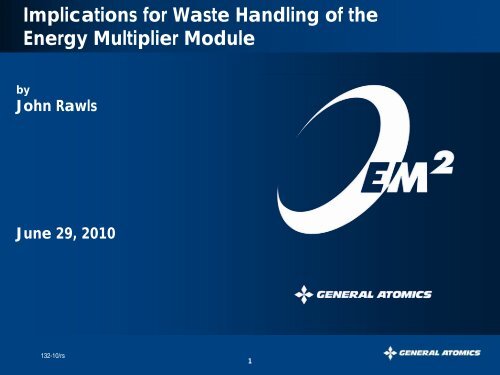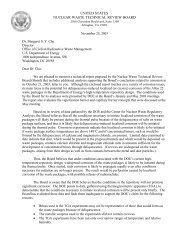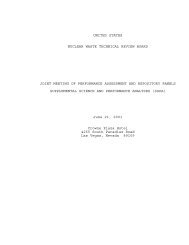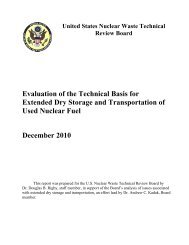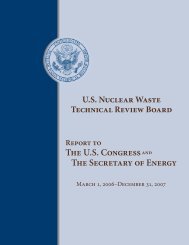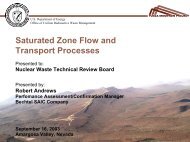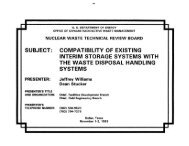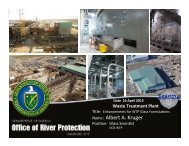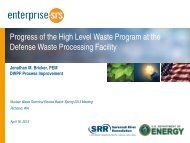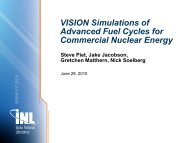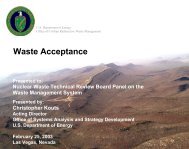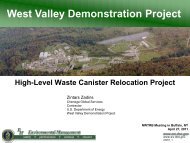John Rawls - US Nuclear Waste Technical Review Board
John Rawls - US Nuclear Waste Technical Review Board
John Rawls - US Nuclear Waste Technical Review Board
Create successful ePaper yourself
Turn your PDF publications into a flip-book with our unique Google optimized e-Paper software.
Implications for <strong>Waste</strong> Handling of the<br />
Energy Multiplier Module<br />
by<br />
<strong>John</strong> <strong>Rawls</strong><br />
June 29, 2010<br />
132-10/rs<br />
1
Changing the Game for <strong>Nuclear</strong> Energy<br />
Key National Issues<br />
1. Economics<br />
2. Used <strong>Nuclear</strong> Fuel<br />
3. Non-Proliferation<br />
4. Energy Security<br />
5. Human Dimension<br />
EM 2 Goals<br />
– To reduce capital investment and<br />
power cost by 30% compared to ALWRs<br />
– To consume & reduce used nuclear fuel<br />
inventory, i.e. minimize need for long-term<br />
repositories<br />
– To reduce need for uranium enrichment;<br />
eliminate conventional fuel reprocessing<br />
– To advance electrification through siteflexibility<br />
& process heat applications;<br />
to reduce foreign energy imports<br />
– To attract eager young minds to a<br />
challenging new enterprise<br />
132-10/rs<br />
2
EM 2 is a Fast Gas-Cooled Reactor in which Fuel is<br />
Made and Burned in situ<br />
Schematic EM 2 core<br />
control drum<br />
fertile<br />
starter<br />
reflector<br />
Argonne National Laboratory<br />
predicted longer core life and<br />
lower excess reactivity<br />
k-effective<br />
1.15<br />
1.10<br />
1.05<br />
1.00<br />
0.95<br />
0.90<br />
0.85<br />
Basics of the breed and<br />
burn in situ approach<br />
• A starter region containing fissile<br />
material provides initial criticality<br />
• The burn spreads to the fertile region,<br />
where it is sustained by newly bred fuel<br />
• The geometrical arrangement has low<br />
excess reactivity for decades, improving<br />
fuel utilization and simplifying control<br />
EM 2 core reactivity<br />
0 10 20 30 40<br />
Time (Yr)<br />
132-10/rs<br />
3
Reactor Concept<br />
Point design features<br />
• 500 MWt, He cooled at 850 o C outlet<br />
suitable for process heat applications<br />
• 240 MW e at ~48% net efficiency (~45%<br />
with dry cooling), at power cost<br />
comparable to natural gas at $7/Mbtu<br />
Grade<br />
Power<br />
Conversion<br />
Module<br />
• Burns used LWR fuel w/o reprocessing<br />
(also DU, natural U, WPu, Th admixture)<br />
• 30 + -yr core w/o refueling or reshuffling;<br />
EOL core can be recycled with 30-60%<br />
fission product removal<br />
• Passively safe, underground sited<br />
• Modules factory manufactured &<br />
shipped by commercial trucks<br />
18 m<br />
5 m<br />
Reactor<br />
132-10/rs<br />
4
Core Composition and Arrangement<br />
Fuel Elements<br />
(typ. of 21 per<br />
layer)<br />
Reactor<br />
Return Flow<br />
Annulus<br />
Core Barrel<br />
Reactor<br />
Vessel Wall<br />
5.0 m (15.6 ft)<br />
B4C Layer<br />
(100 mm<br />
thickness)<br />
Graphite<br />
Reflector Layer<br />
(500 mm<br />
thickness)<br />
BeO Layer (250 mm<br />
minimum thickness)<br />
Material irradiation data is encouraging about the life of SiC structure<br />
Fuel Element<br />
17,136 units<br />
SiC-SiC<br />
clad<br />
porous UC<br />
plate<br />
SiC-SiC Assembly<br />
Frame<br />
Positions plates<br />
for cooling & FP<br />
control<br />
Fuel Assembly<br />
357 units<br />
• Handling unit<br />
• Stackable<br />
• Transfers fission gas<br />
5.19kg<br />
Fission gas<br />
movement<br />
Fission gas<br />
movement<br />
257kg<br />
132-10/rs<br />
5
Used <strong>Nuclear</strong> Fuel/DU and Partial Closing of<br />
the Fuel Cycle<br />
132-10/rs<br />
6
Energy Security: Fuel Utilization 1 Improves with<br />
Number of Cycles<br />
50%<br />
45%<br />
Fuel Utilization<br />
40%<br />
35%<br />
30%<br />
25%<br />
20%<br />
EM 2 First Cycle:<br />
2X LWR Utilization<br />
SNF waste<br />
U.S. SNF inventory: 61,000 t<br />
15%<br />
2<br />
U.S. DOE NE Goal: 10%<br />
10%<br />
5%<br />
0%<br />
LWR 0.5%<br />
1 2 3 4 5 6 7 8 9 10 11 12 13 14 15 16 17 18 19 20<br />
Number of EM 2 Cycles<br />
1<br />
Percent of mined heavy metal that is fissioned 2<br />
U.S. Department of Energy, <strong>Nuclear</strong> Energy<br />
DU waste<br />
U.S. DU inventory: 700,000 t<br />
Energy in U.S. SNF & DU<br />
inventory is 5 x world’s<br />
proven oil reserves<br />
132-10/rs<br />
7
Quantity of <strong>Waste</strong> Produced<br />
<strong>Waste</strong> (tonnes)<br />
12000<br />
10000<br />
8000<br />
6000<br />
4000<br />
2000<br />
0<br />
-2000<br />
LWR<br />
EM 2<br />
0 100 200 300 400<br />
<strong>Waste</strong> vs years of operation for a<br />
continuously operating1.2 GWe plant<br />
Impact on repository sizing<br />
(stated on a per unit energy<br />
supplied basis)<br />
• Higher burnup and higher<br />
efficiency mean lower end of<br />
life fuel mass & volume<br />
• These amounts are reduced<br />
further (linearly) by the<br />
number of times fuel is reused<br />
• These figures of merit are<br />
further improved if spent LWR<br />
fuel is used as fuel<br />
Total waste in 400 years: LWR 12,000t, EM 2 < 400t<br />
132-10/rs<br />
8
Implications for <strong>Nuclear</strong> <strong>Waste</strong><br />
1.E+07<br />
EM 2 Decay After 30-year Burnup<br />
1.E+05<br />
EM 2 Core Decay Heat After 30-year Burnup<br />
Actinides<br />
Fission Products<br />
1.E+04<br />
Decay Activity (Curies)<br />
1.E+06<br />
1.E+05<br />
1.E+04<br />
Decay Energy (Watts)<br />
1.E+03<br />
1.E+02<br />
1.E+01<br />
Actinides<br />
Fission Products<br />
1.E+00<br />
1.E+03<br />
1.E-01<br />
1 10 100 1000 10000<br />
1 10 100 1000 10000<br />
Decay Time (years)<br />
Decay Time (years)<br />
__________________________________________________________________________________________<br />
FP radiological data<br />
• FP makeup quite similar to that of LWRs except<br />
that Cs is removed from the core during the burn<br />
• After 300 yrs, primary FPs are 99 Tc & 151 Sm, two<br />
weak beta emitters; FP heat load is few W/core<br />
Actinide radiological data<br />
• If restricted to one burn cycle, actinide content<br />
per unit energy produced is similar to that of LWRs<br />
and is reduced linearly with the number of cycles<br />
• Long core residence postpones repository need<br />
132-10/rs<br />
9
Non-Proliferation<br />
Dry cask storage<br />
1. Reduces fuel handling and eliminates long-term<br />
storage of spent fuel containing significant Pu.<br />
Uranium enrichment<br />
2. Eliminates need for conventional reprocessing<br />
(heavy metal chemical separation).<br />
3. Both discharged and refabricated EM 2 fuel<br />
meets self-protection requirements for 20 yrs.<br />
Geological repositories<br />
4. Below-grade reactor core is inaccessible without<br />
special remote handling equipment.<br />
5. Low excess reactivity- core cannot be easily<br />
reconfigured for material insertion/extraction<br />
132-10/rs<br />
10<br />
10<br />
185-09/RWS/rs
Comparative Power Generation Costs<br />
30% cost reduction is a result<br />
of the following attributes<br />
• Less materials<br />
• Factory labor<br />
• Shorter construction time<br />
• Smaller facility footprint<br />
• Higher efficiency<br />
• Decades of life —<br />
no refueling/no shuffling<br />
• Simple control<br />
• Bankablility of fuel<br />
ALWR, coal and natural gas data source: MIT 2009 Cost Update; EM 2 model estimate.<br />
All power generation costs evaluated for a 30-yr levelization period<br />
132-10/rs<br />
11
DOE-NE Comprehensive EM 2 Peer <strong>Review</strong><br />
- Core physics and depletion<br />
- Core thermal hydraulics<br />
- Fuels<br />
- Fission product transport<br />
- Used fuel management<br />
- Structural materials<br />
- Balance of plant<br />
- Safety<br />
- Non-proliferation<br />
- Cost/economics<br />
Key findings:<br />
• Most significant risks are associated with 30-yr core in fast neutron fluence, including<br />
fuel thermal-chemical performance and dimensional stability, SiC clad integrity, and<br />
fission product transport<br />
• Report affirms the reactor physics design and that EM 2 supports all five DOE-NE goals<br />
132-10/rs<br />
12<br />
185-09/RWS/rs
GA’s Internally-Funded Program Addresses<br />
Fuel and Power Conversion<br />
CY2010 GA-Funded Work<br />
UC Lab<br />
- Bench-scale UC fab facility<br />
- Bench-scale SiC fab facility<br />
- Fuel fab process optimization<br />
- Physics methods upgrade<br />
- Reactivity control design<br />
- EM 2 fuel metrology lab<br />
- High-speed generator<br />
- High-voltage inverter<br />
- Reactor concept optimization<br />
- Power conversion design<br />
- Selected accident analyses<br />
- FP transport component fab<br />
SiC Composite Lab<br />
SiC coater<br />
High-speed<br />
Gas Turbine<br />
132-10/rs<br />
13<br />
13<br />
185-09/RWS/rs
Summary<br />
• Significant capital & power cost reduction<br />
• Reduces (and potentially consumes) the used<br />
nuclear fuel inventory, thereby easing repository<br />
requirements and possibly delaying their need<br />
• Reduces long-term need for enrichment;<br />
eliminates need for conventional reprocessing<br />
• Formidable technical challenges are attracting<br />
eager young minds to a new nuclear enterprise<br />
with a long-term future<br />
132-10/rs<br />
14
Backup Slides<br />
132-10/rs<br />
15
EST Also Offers Promise for Used <strong>Nuclear</strong> Fuel<br />
Fission Products<br />
Heavy Metals<br />
• Uses mass gap between actinides and lanthanides<br />
• Separation of trivalent actinides and lanthanides considered to be the<br />
most difficult current reprocessing steps<br />
– Necessary for both repository management and recycled fuel<br />
• Filter throughput 30X less than wastes much smaller size plant<br />
132-10/rs<br />
16
EST Technology Proof of Principle has Occurred<br />
• Physically separates based on mass/charge using electromagnetic fields<br />
• Advantages for nuclear wastes<br />
– Relatively indifferent to<br />
waste complexity<br />
– Excellent separation efficiency<br />
– Single step process<br />
– Reduced waste streams<br />
– Significant net cost savings<br />
and risk reduction<br />
• Advantages for used nuclear fuel processing<br />
– Separates fission products<br />
– Not capable of TRU separation by element or isotopes<br />
– Supportive of new reprocessing-free closed fuel cycle options<br />
132-10/rs<br />
17
Technology Needs & Research Challenges<br />
• Efficient and effective separation of fission products<br />
from reactor discharge<br />
• Understanding properties of materials under high<br />
neutron fluences and high temperatures<br />
• Behavior of fuel and fission products over decades<br />
• Defining and establishing manufacturing base to<br />
realize the cost-effective fabrication of modular<br />
reactors like EM 2<br />
132-10/rs<br />
18
EM 2 is More Proliferation-Resistant than<br />
Alternative Reactor Concepts<br />
Portion of<br />
Fuel Cycle<br />
Attribute of<br />
Fuel Cycle<br />
Light Water<br />
Reactor<br />
Traditional<br />
Fast Reactor<br />
EM 2<br />
Front end Need for enrichment? Yes<br />
Gen 1: yes<br />
Gen 2: no<br />
Gen 1: yes<br />
Gen 2: no<br />
Operations<br />
Fuel residence time<br />
Sealed vessel?<br />
< 5 yr<br />
No<br />
< 5 yr<br />
No<br />
> 30 yr<br />
Yes<br />
Back end Planned reuse of fuel None<br />
Yes, with Pu<br />
separation<br />
Yes, without<br />
Pu separation<br />
Proliferation vulnerability legend<br />
LOW MODERATE HIGH<br />
132-10/rs<br />
19<br />
185-09/RWS/rs


